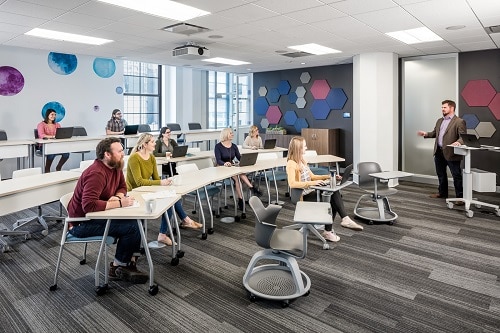You’re committed to improving the way people work at their jobs. You want the talent in your company to share your enthusiasm for a vision of working smarter. And COVID-19 has made it necessary to maintain that focus in light of new requirements.
Digital transformation creates the hybrid workplace
Digital workplace transformation requires people and an organizational structure that are open to change. To gain consensus for workplace transformation, learn how your staff want to work and their current struggles. Also, find out what kind of functions they expect of their technology systems.
COVID-19 and the demands it has placed on us has helped to clarify some of these answers. By collaborating with consultants and internal focus groups, you’ll identify the capabilities that people need to be productive. The solutions providing that improvement may include a catalog of meeting spaces with a variety of systems. Those systems may empower video collaboration, simple control of room devices, interactivity with touch panels, and wireless presentation of content. The technology for the hybrid workplace will also have to address post-pandemic needs like:
The goal is a hybrid workplace where the technology systems fit the workplace culture while also meeting new must-haves like employee health. Because change will affect the entire company, give a voice to different stakeholders, including representatives from HR, marketing, finance, operations, and other departments. By doing so, you’ll find the right unified communications and collaboration tools for your workers.
JLL’s tips for creating digital transformation
To promote digital transformation, follow these steps laid out by JLL:
- Those in leadership positions must endorse the commitment to change. If the executives don’t believe in the plan, why should the rest of the company?
- Understand why employees might be resistant to change. If they are resisting because they think they don’t have the ability to change, or because they won’t have sufficient support, work through these obstacles through workshops and training sessions.
- The resistance can be cultural (“this is how we’ve always done things”) and personal (“we don’t have the skills “). When you understand different cultures and how they can affect your strategy, you can address employee resistance through training and new processes.
- Your company’s circumstances should dictate how you implement change. Some companies can change quickly, while others would be better off with an incremental process.
- Manage your strategy. Be flexible and willing to change the strategy as you learn more about the way your company operates.
COVID-19 has created an environment where more people across the company are willing to change how they work. But you should still focus on a couple of internal groups or departments that would benefit from better collaboration with one another. As they are successful, they can be part of the advocate groups who share their best practices with the rest of the company.
During our Collaboration Space podcast, we spoke with JLL’s Dusty Duistermars. Duistermars shares his insights on COVID-19 and its impact on our return to the workplace. He also addresses topics like remote work, and collaboration space design.
Work with AVI-SPL on your digital transformation goals
As you commit to workplace transformation, consider how your organization’s value could be delivered more effectively. AVI-SPL helps companies improve their ability to collaborate in teams because it gives them the technology tools that today’s workers expect to have. We also make them easy to use. One reason for that ease is automation, which has taken on a higher profile amidst COVID-19. Rooms are designed for a minimal number of user interactions to engage any of the major functions. And scalable cloud-based services automate the scheduling, launching, and management of meetings so that they start on time and with no inconvenience to the participants.
AVI-SPL designs, integrates, and supports the type of meeting spaces where it’s easy for participants to start video collaboration meetings, connect personal devices to room systems, and present materials to in-room and remote participants. Among AVI-SPL’s case studies, you’ll find many examples of corporations, museums, and schools using interactive displays to engage their guests so they can find information and get a favorable view of the organization.

